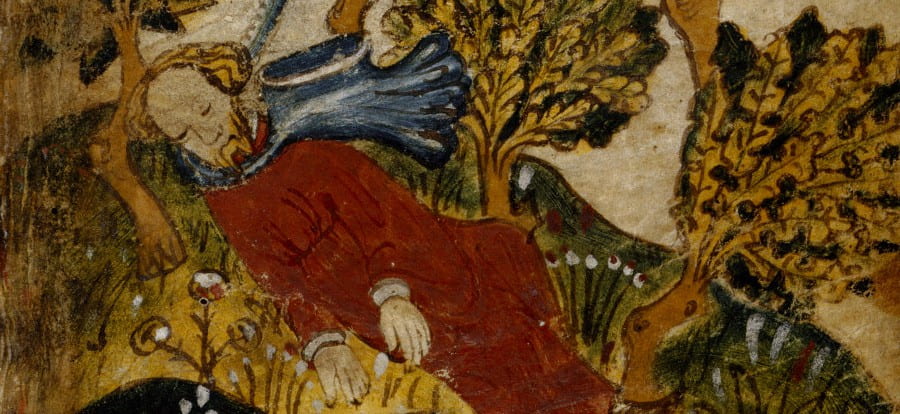| Category | Text |
| Form | Poetry |
| Genre | Medieval Allegory, Dream Vision |
| Author | Pearl Poet / Gawain Poet |
| Time | Late 14th Century |
| Language | Middle English |
| Featured In | Death, Mourning and Memory in Medieval Literature (YHU3345) |
Like many medieval poems, Pearl takes place mostly within a dream, a literary convention that allows the poet to explore ideas and convey experiences that might otherwise be impossible to express in language—in the case of this poem, the loss of a child.
SUMMARY

The poem begins in a lush garden of herbs and flowers to which the narrator has returned to mourn his lost “pearl,” since it was here that the pearl first slipped from his grasp and into the ground. Overcome by grief, he swoons into unconsciousness and awakens in an exquisitely beautiful landscape, where crystal cliffs overlook a bright stream winding through a forest of burnished silver. Across the river, he catches sight of his own lost pearl—but now she is not simply a jewel but a young girl dressed in brilliant white robes covered in pearls. The dreamer gradually recognizes her but also sees that she has been radically transformed (though we learn that his daughter lived less than two years, here she appears as a mature being capable of thoughtful, articulate speech). In the conversation that follows, the pearl-maiden tries to convey something of the nature of eternity to the dreamer, who seems to flicker in and out of understanding. Toward the end of the poem, she reveals a dazzling vision of the heavenly city. Mesmerized, the dreamer plunges into the river to swim toward her, but is abruptly thrown out of his dream and awakens once more in the garden, where he meditates on this transcendent vision.
FORM AND STRUCTURE
One of the most striking features of the poem is its remarkably intricate form: each of the 101 stanzas has an ababababbcbc rhyme scheme, with a high degree of alliteration. This creates an echoing effect that is intensified by the use of “concatenation,” or linking together through repetition (the word comes from the Latin catena, meaning “chain”). In each group of five stanzas, there is a single “concatenation word” that appears multiple times, each time with slightly different shades of meaning—as if the poet is holding up each word to the light and examining its different facets. This word appears again in the first line of the next stanza group, producing what poet and translator Simon Armitage calls a “poetic passing of the baton”; finally, the last line of the poem repeats the first almost exactly, evoking a “spherical endlessness reminiscent of the pearl itself” (Armitage 11).
THEMES
In imitating the formal perfection of the pearl, the poem invites readers to reflect on the relationship between beauty and loss, or the role of the aesthetic in thinking about death. At the same time the poem calls attention to the limits of language in representing the infinite: in the end, its repetitions undo any sense of singular meaning and remind us that death will remain always beyond our understanding.
AUTHORSHIP

Almost nothing is known about the author of the poem. It survives in a single, unassuming manuscript that contains three other works almost certainly by the same author (Patience, Cleanness, and Sir Gawain and the Green Knight). The manuscript itself (known as Cotton Nero A.x.) was almost lost when a terrible fire broke out in the London library where it was being stored in the early 18th century. We can only speculate about the circumstances of the poem’s creation: on one level, it is a work of religious instruction, full of biblical allusions and drawing on the New Testament as inspiration for its central image of the pearl. But the poem also communicates an emotional anguish that suggests that it is drawn from actual experience, from the genuine grief of a father who has lost a daughter.
REFERENCES
Simon Armitage, Pearl: a new verse translation (London: Norton, 2016).
ADDITIONAL RESOURCES
J.R.R Tolkein’s translation of the poem: https://allpoetry.com/poem/8499963-Pearl-by-J-R-R-Tolkien
Pearl manuscript at the British Library: https://www.bl.uk/collection-items/pearl#
Dream visions: https://www.bl.uk/medieval-literature/articles/dream-visions
Illustrations to Pearl: https://medievalpearl.wordpress.com/illustrations/
IMAGE CREDITS
[Featured Image, Fig. 1 & 2] https://medievalpearl.wordpress.com/illustrations/
CONTRIBUTED BY DR. EMILY DALTON

